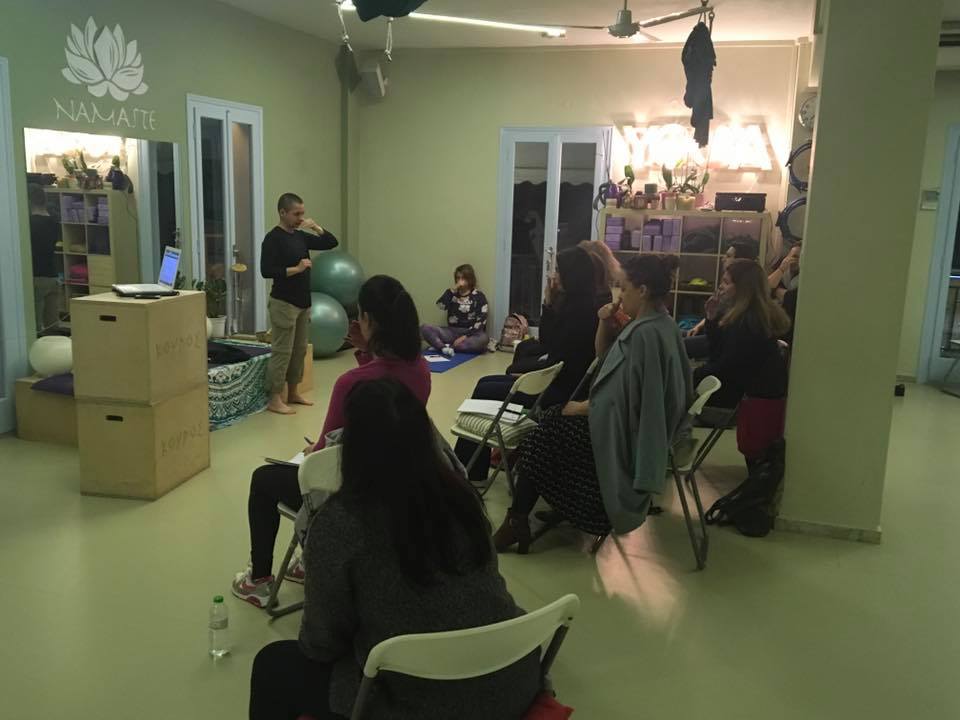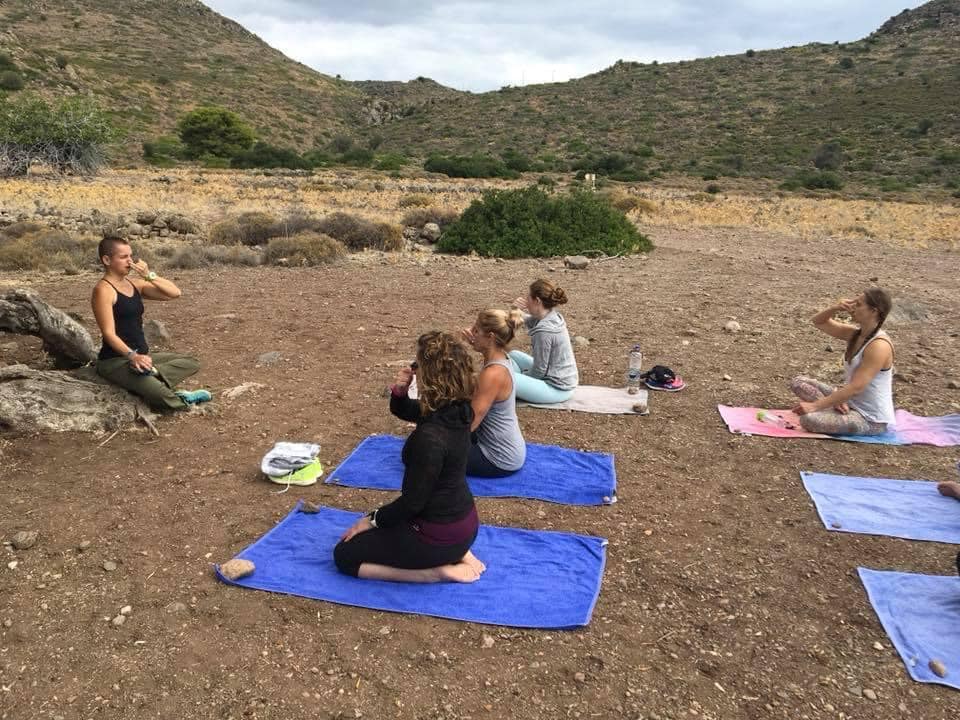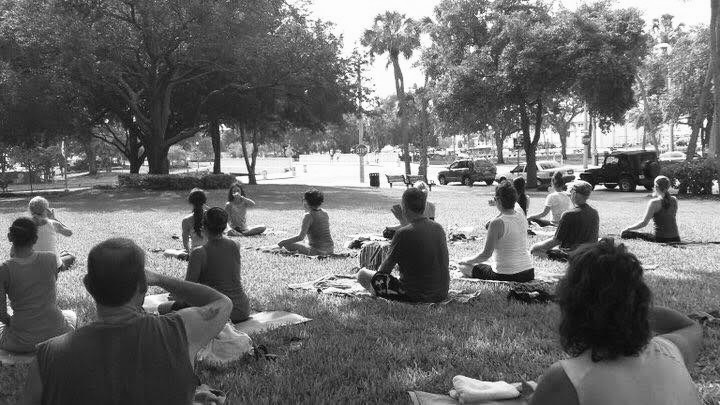Mount Yonah Gym: The Power of Alternate Nostril Breathing | A Simple Practice That Changes Everything
A breathwork technique we’ve taught for 25 years – and why the science backs it up
Hello Everyone! Tim and I are excited to share one of our favorite breathwork practices with you today – alternate nostril breathing. This incredibly simple yet powerful technique has been a cornerstone of our classes. We’ve watched it create profound shifts in our students’ daily lives, and we’ve seen firsthand how accessible and effective it truly is.
In the yoga tradition, breathwork practices like this one are called pranayama, and this particular technique is known in Sanskrit as nadi shodhana – but don’t let the fancy name intimidate you! The beauty of this practice is its simplicity.
Understanding Pranayama: Working With, Not Against
Before we dive into the technique itself, let’s talk about what pranayama really means. You’ll often hear it translated as “controlling the breath,” but Sanskrit is such a rich language that this barely scratches the surface.
The truth is, we really can’t control anything. We can’t control nature, we can’t control the mountain (and believe us, Mount Yonah has taught us that lesson many times!), we can’t control the weather. What we can do is learn to work with them – to become part of them. You become part of the mountain, you become part of the weather, and yes, you become part of your breath.
From our study with Sanskrit teachers Nicolai Bachman and Manisha Kshirsagar, we’ve learned an important distinction that helps clarify this concept:
- pranayama (lowercase ‘p’) refers to the breath as we commonly understand it – the physical act of breathing in and out
- Pranayama (capital ‘P’) refers to Prana – our life force itself
Our breath, the way we normally think about it, is just one manifestation of our life force, just like our pulse. The breath we can feel and control is simply how Prana, our life force shows up in our physical experience.

The Beauty of Simplicity
Here’s what we love about alternate nostril breathing: it’s incredibly simple, has virtually no contraindications (even pregnant women can practice it safely), and yet it’s profoundly effective. The only real limitation? If your nose is stuffed – especially one nostril – please don’t force it. Work with your breath, work with Mother Nature. Don’t try to control it.
As always, please check with your healthcare provider, and never do anything that doesn’t feel good. We bear no responsibility for your practice – listen to your body above all else.
How to Practice: Step by Step
Getting Set Up
When to practice: On an empty stomach (this applies to all breathwork) Position: Sitting upright – you can have your back against a couch, wall, or chair for support Preparation: Make sure your nose is relatively clean (and yes, Tim always has to stop mid-practice to “send little friends out onto the mat” – they like to keep him company!)
The Technique
We’re going to teach you the most basic, accessible form first. Forget any complicated finger positions you might have seen on Instagram – those fancy mudras are often just arbitrary, man-made rules designed to impress and photograph well. Instagram has done a lot for different hand positions, both good and not so good!
What you’ll actually do:
- Use your right hand with any two fingers you’re comfortable with. For most people, the thumb and index finger work perfectly.
- Start the cycle:
- Use your right thumb to close your right nostril
- Exhale completely through your left nostril only
- Pause briefly
- Inhale through your left nostril (right still closed)
- Switch sides:
- Use your right index finger to close your left nostril
- Release your thumb and exhale through your right nostril
- Inhale through your right nostril
- Complete the cycle:
- Close your right nostril with your thumb again
- Open your left nostril and exhale through the left
- Inhale through the left
- Repeat this pattern for 2-3 minutes
That’s it! No complicated counting, no rigid timing rules. Just this simple, rhythmic alternation between nostrils.
Progression: From Beginner to Advanced
Week 1-2: Just Get Started
When you first begin, don’t worry about anything except the basic pattern. Sit there, set a timer for two minutes, and simply exhale and inhale through one nostril at a time. That’s enough.
Week 3-4: Notice the Natural Slowing
After practicing regularly (once a day or every other day), you’ll start noticing something magical: your inhales and exhales naturally begin to slow down. They’re not as fast or nervous as they were in the beginning. This is when the real practice begins.
The First Goal: Longer Exhales
One of your first milestones is noticing that your exhale becomes just a touch longer than your inhale. This isn’t something you force – it happens naturally as you settle into the practice.
Why does this matter? When your exhale is longer, you’re releasing more of the “dirty air” out (yes, that’s our technical term!), making room for fresh air to come in. You’re releasing toxins and bringing fresh air in. If your exhale isn’t long or deep enough, you leave stale air behind, and there’s less room for fresh air on your next inhale.
Advanced Practice: The Power of Pauses
Once your breath has naturally slowed and your exhales have lengthened, you’re ready for the most transformative aspect of this practice: the pauses.
After inhaling: When you have a lungful of fresh air, see if you can pause. Keep that air in for a bit, and don’t exhale until your body truly needs to. Trust us – your body will let you know when it’s time. This is the beauty of breathwork being part of both our voluntary and autonomic nervous systems.
After exhaling: Hold most of the air out for as long as comfortable, and don’t take a breath in until your body needs to. Let your body breathe in for you.

The Science: What Research Tells Us
Over the past decade, scientific research has caught up with what yogis have known for centuries. We love that modern science is validating what we’ve been teaching all these years!
A comprehensive systematic review of 44 randomized controlled trials found high-level evidence that alternate nostril breathing provides positive outcomes for the autonomic nervous system, cardiopulmonary system, and cognitive functioning.
Here’s what the research shows:
Autonomic Nervous System Benefits: Studies demonstrate that alternate nostril breathing significantly enhances parasympathetic tone, helping activate your body’s rest-and-digest response. This is why so many of our students report feeling calmer and more centered after practicing.
Cardiovascular & Respiratory Improvements: Research on healthy young adults found that just four weeks of alternate nostril breathing practice improved cardiorespiratory functions, including pulse rate, blood pressure, and lung capacity measures. These aren’t subtle changes – they’re measurable improvements in how your heart and lungs function.
Brain Function & Connectivity: Recent high-density EEG studies show that alternate nostril breathing decreases certain brain wave patterns associated with anxiety while increasing theta oscillations linked to relaxed alertness and cognitive control. Your brain literally shifts into a different state during this practice.
Anxiety Reduction: Even a short 15-minute practice of alternate nostril breathing has been shown to influence mood states and reduce experimentally-induced anxiety in healthy young adults. This is why we often recommend it before stressful situations or important meetings.
Memory Enhancement: Studies on female subjects found that alternate nostril breathing significantly improved both verbal and spatial memory scores, suggesting benefits for cognitive performance that go beyond just feeling calmer.
Intermittent Hypoxia: Training Your Body
This breath retention practice creates what’s called intermittent hypoxia – training your body to operate with less oxygen. Think of it like intermittent fasting for your respiratory system. Just as intermittent fasting trains your body to operate without constant food intake, intermittent hypoxia trains your body to operate without constant breathing.
This is hormesis – the beneficial stress that comes from challenging ourselves in controlled ways. As human beings, we’re not designed to have comfort all the time. We’re actually meant to learn to be comfortable under conditions that today we would call uncomfortable.

Special Considerations
For Smokers
If you smoke, this practice might be more challenging initially due to how your lungs are conditioned. Start with just 30 seconds to one minute instead of two. As long as you practice regularly and avoid smoking right before and after your practice (give it 5-10 minutes buffer), this breathwork will help you tremendously.
Daily Integration
We love having our students practice this in their cars before leaving for work or before heading home. It completely changes your mental disposition – and that’s exactly what it’s supposed to do, because our breath and our mind are interlinked. The way our breath is, the way our mind is.
You can set timers throughout your day as gentle reminders to return to this practice. Just remember: never while driving!
Teaching in Groups
When we teach this in our classes at Mount Yonah Gym, we give an average pace rather than strict counts. Experienced practitioners know to follow their own rhythm, while newcomers don’t feel forced to keep up with unrealistic expectations. The real magic happens in individual practice where you can truly honor your own pace and progression.
The Deeper Purpose
At its heart, alternate nostril breathing is about relationship – your relationship with your breath, your life force, and ultimately, yourself. It’s a practice that teaches us to work with rather than against our natural rhythms. It shows us that we don’t need complicated techniques or fancy equipment to access profound transformation.
In our modern world of constant stimulation and comfort, this simple practice offers something revolutionary: the opportunity to be comfortable with temporary discomfort, to find stillness within movement, and to remember that our breath is always available as a gateway to presence.
Getting Started Today
Ready to begin? Here’s your invitation:
- Find a quiet spot where you can sit comfortably upright
- Set a timer for just 2 minutes
- Follow the simple technique we’ve outlined above
- Don’t worry about perfection – just show up and breathe
Remember, this is a practice, not a performance. Some days will feel easier than others, and that’s completely natural. The key is consistency, not intensity.
Join Us at Mount Yonah Gym (MY Gym)
If you’re in the Northeast Georgia area, we’d love to have you join one of our classes where we can guide you through this and other breathwork techniques in person. Join us at Mount Yonah Gym
Until next time, much love from both of us. May we all be well, adapt, and thrive. -Tim & Vie
Research References
For those interested in diving deeper into the science behind alternate nostril breathing, here are the peer-reviewed studies we referenced:
Systematic Reviews
- Ghiya, S. (2017). Alternate nostril breathing: a systematic review of clinical trials. International Journal of Research in Medical Sciences, 5(8), 3273-3286.
Read the full study
Autonomic Nervous System
- Assessment of the Effects of Pranayama/Alternate Nostril Breathing on the Parasympathetic Nervous System in Young Adults (2013). Journal of Clinical and Diagnostic Research.
Read the full study
Cardiovascular & Respiratory Function
- Effects of Alternate Nostril Breathing Exercise on Cardiorespiratory Functions in Healthy Young Adults (2021). PMC.
Read the full study - Effect of alternate nostril breathing exercise on autonomic functions, ocular hypertension, and quality of life in elderly with systemic hypertension (2023). ScienceDirect.
Read the full study
Brain Function & Cognitive Performance
- Frohlich, A.B., Frohlich, F., & Sklerov, M. (2025). Neuronal oscillations and functional connectivity of paced nostril breathing: A high-density EEG study. PLOS ONE.
Read the full study - Hemisphere specific EEG related to alternate nostril yoga breathing (2017). BMC Research Notes.
Read the full study - Effect of Left, Right and Alternate Nostril Breathing on Verbal and Spatial Memory (2016). Journal of Clinical and Diagnostic Research.
Read the full study
Anxiety & Stress Reduction
- Effect of Alternate Nostril Breathing Exercise on Experimentally Induced Anxiety in Healthy Volunteers Using the Simulated Public Speaking Model (2017). PMC.
Read the full study
These studies represent peer-reviewed research from respected medical and scientific journals, demonstrating the growing body of evidence supporting what yogic traditions have taught for centuries.

1 thought on “Mount Yonah Gym: The Power of Alternate Nostril Breathing | A Simple Practice That Changes Everything”